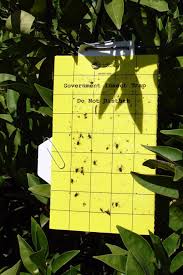
Ok, I’m grateful for more than just the traps, but they represent an essential first step in our efforts to exclude invasive species from California, and then respond as effectively as possible if we find them.
Yellow sticky traps are used to detect pests such as Asian Citrus Psyllids and Glassy-Winged Sharpshooters, which are major threats to crops like citrus and grapes. The two insects spread fatal plant diseases–huanglongbing and Pierce’s disease, respectively–and while scientists search for potential cures, CDFA plant health specialists work closely with county agriculture commissioners and the USDA to manage pest populations to reduce the risk to citrus and grapes.

Those are just two examples of work that goes on in many arenas to carry out CDFA’s core function of protecting agriculture and natural resources from crop and vegetation destruction.
CDFA prioritizes Integrated Pest Management (IPM) in this work. IPM is a process for excluding or rapidly responding to invasive species while minimizing risks to people and the environment. We have been engaged in this for decades and have developed cutting-edge scientific approaches. Examples are the use of sterile insect technology and biocontrol to avoid the use of pesticides.
I am grateful for our Plant Health and Pest Prevention Services Division and the talented, our dedicated staff at our border stations and laboratories, and our staff members doing the detection and pest management work in the fields and urban neighborhoods throughout the state.
As we move deeper into the 21st century, I believe we can look forward to IPM advances that will make us even better at detecting and eradicating these dangerous pests. But a simple yellow sticky trap helps us get the job done now, and I appreciate that very much.


